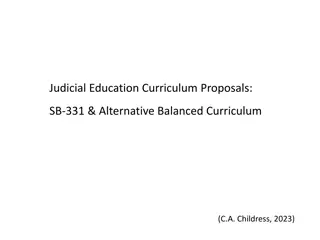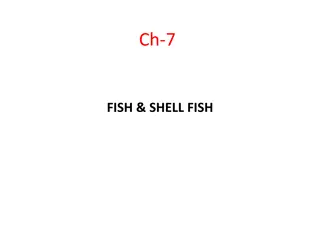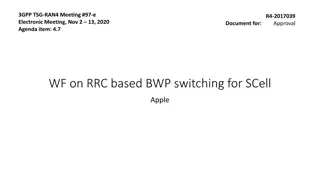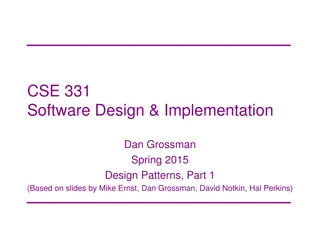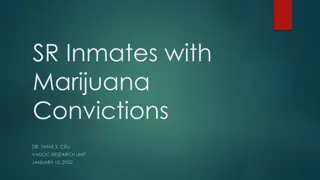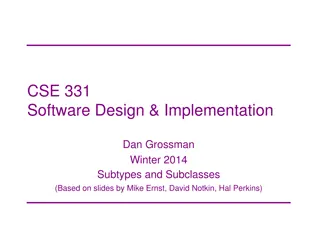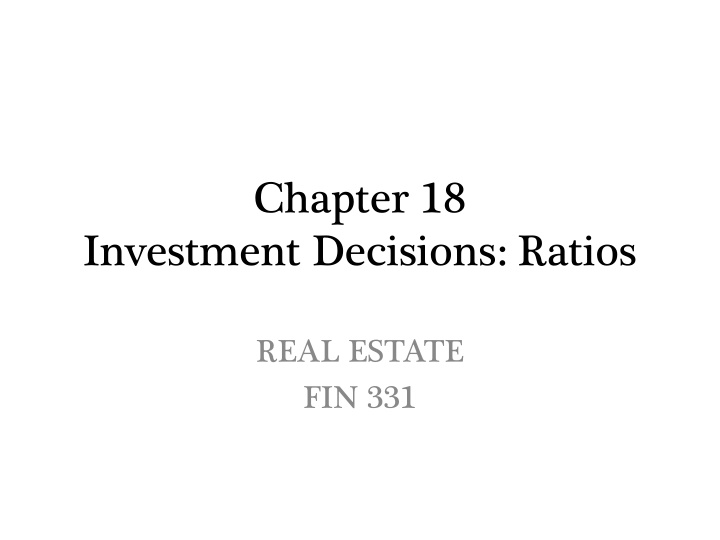
Real Estate Investment Decisions: Ratios and Decision-Making Process
This content discusses the key aspects of real estate investment decisions, focusing on the difference between investment value and market value, the importance of considering future income streams, the use of ratios in decision-making, and cautionary notes about quantitative tools in establishing value. It also provides an example of estimating net operating income for a property. The content emphasizes the need to consider various factors beyond the first year when analyzing real estate investments.
Download Presentation

Please find below an Image/Link to download the presentation.
The content on the website is provided AS IS for your information and personal use only. It may not be sold, licensed, or shared on other websites without obtaining consent from the author. If you encounter any issues during the download, it is possible that the publisher has removed the file from their server.
You are allowed to download the files provided on this website for personal or commercial use, subject to the condition that they are used lawfully. All files are the property of their respective owners.
The content on the website is provided AS IS for your information and personal use only. It may not be sold, licensed, or shared on other websites without obtaining consent from the author.
E N D
Presentation Transcript
Chapter 18 Investment Decisions: Ratios REAL ESTATE FIN 331
Investment Decision-Making A. Defining the difference between Investment Value and Market Value 1. Market Value reflects the value of the land and structures thereon. 2. MV is the basis for economic transactions. 3. No buyer wants to pay more than market value of property.
Investment Decision-Making 2. Investment Value takes into consideration future income streams resulting from the acquisition of a property a. Rental rates b. Vacancy rates c. Operating expenses d. Potential future capital investment e. Risk attributes
Investment Decision-Making A. Real Estate Investment Decisions 1. Focus is on Ratios a. Easy to calculate b. BUT.. Do no explicitly consider cash flows beyond the 1styear. 2. Many investors perform multi-year cash flow analysis in attempts to determine their present value (Discounted Cash Flow analysis) a. Present Value of future [after-tax] cash flows = Price
Words of Caution A. Use of quantitative tools is not fool proof method for establishing value. 1. Problem with usefulness of cash flow projections. a. Impact of economic cycles b. Volatility of interest rates (opportunity costs) c. Nature of assumptions made about the future 1) Rental rates 2) Vacancy rates 3) Operating Expenses
Centre Point Office Building Review of Assumptions
Investment Decision-Making A Estimating net operating income for the next year PGI Potential Gross Income - VC Vacancy & Collection Loss + MI Miscellaneous Income = EGI Effective Gross Income - OE Operating Expenses - CAPX Capital Expenditures = NOI Net Operating Income - DS Debt Service* = BTCF Before Tax Cash Flow - TAX Fed, State, Local Taxes = NI Net Income
Centre Point: Projected 1st-Year NOI Potential gross income (PGI) Vacancy & collection loss (VC) = Effective gross income (EGI) Operating expenses (OE) Capital expenditures (CAPX) = Net operating income (NOI) $180,000 18,000 162,000 64,800 8,100 $ 89,100
Operating vs. Capital Expenditures A.Operating expenses: 1. Keep property operating & competitive 2. Do not increase value or extend useful life 3. Examples: minor roof repairs, air conditioner servicing, lawn maintenance, utilities, etc. B.Capital Expenditures: (below the NOI line) 1. Increases market value of property a. Installation of new landscaping b. Roof replacement, air-conditioner replacement
Operating vs. Capital Expenditures A. Some Treat CAPX as a Reserve (above the line), some below the line 1. Above: PGI VC = EGI OE CAPX = NOI 2. Below: PGI VC = EGI OE = NOI CAPX = NCF (Net Cash Flow) 3. Note: CAPX [below the line] is not a tax deductible expense : it gets amortized as depreciation
Operating vs. Capital Expenditures B. NOI as the expected dividend from property C. NOI must be sufficient to: 1. Service the mortgage debt and 2. Provide investor with an acceptable return on equity (ROE) Note: Text assumes above the line treatment for Cap. Ex. for simplicity
Use of Leverage (Debt) A. Why do investors borrow? 1. Limited financial resources/wealth 2. Leverage amplifies equity returns (& risk) 3. Also permits more portfolio diversification B.Cash flow effect of borrowing: Net operating income Debt service (book uses P&I, IRS allows just interest to be deducted) = Before-tax cash flow (BTCF)
Centre Point Example A. Acquisition Price: $1,056,000 B. 25% cash down, finance 75% = $792,000 C. Loan @ 6.5%, 30-year term, amortized monthly, Loan Fees = 3% = $23,760 1. Net Loan Proceeds: $792,000 $23,760 2. Initial Equity = $1,056,000 - $768,240 = $287,760 3. Payment = $5,005.98 or $60,072 per year 4. First Year Interest = $51,219.36
Centre Point: Before Tax Cash Flow = Net operating income - Debt service 51,219* =Before-tax cash flow (BTCF) $37,881 *Note: The text uses $ 60,072 as the debt service amount. A note in the next chapter acknowledges that the IRS allows only the interest to be deducted. $89,100
IRS Regulations A. Deductible Expenses 1. Include only income & expenses that relate directly to income producing ability of property 2. IRS Publication 535 describes deductible business expenses
Evaluating Cash Flows A. Considerations 1. Comparables a. Getting data may prove difficult b. Commercial RE agents may be helpful 2. Legal Issues a. Zoning b. State and local laws/regulations 3. Miscellaneous Issues a. Property tax trends b. Economic goals of local government: pro or anti-growth
Financial Risk Ratios (see Exhibit 186) A. Operating Expense Ratio = Operating Expenses divided by Effective Gross Income B. Loan-to-Value Ratio = Loan divided by Fair Market Value C. Debt Coverage Ratio = Operating Income divided by Debt Service D. Debt Yield Ratio = first year NOI divided by the first mortgage loan
Other Ratios A. Profitability ratios 1. Capitalization rate (Ro) = [NOI / Price Paid] 2. Equity dividend rate [=NOI / Equity] B.Multipliers 1. Net Income Multiplier: NIM = Acquisition Price / NOI1 2. Effective Gross Income Multiplier: EGIM = Acq. Price / Effective Gross Income
Centre Point Capitalization Rate Issues A. Is 8.44% an acceptable [overall] cap rate? 1. Question can only be answered by comparisons with cap rates on similar properties 2. A DCF analysis may yield a different cap rate B. Investors should rely on cap rate information abstracted from comparable transactions in the local market 1. However, regularly published surveys also provide useful information on cap rate trends
Profitability Ratios A. Equity Dividend Rate Before = EDR tax cash flow Equity investment B. Centre Point Example* 37 $ = EDR 881 , = 1316 . 0 , or 13 16 . % 287 $ 760 , 1. Residual Cash Flow ~ cash-on-cash return on equity
Common Multipliers A. Net Income Multiplier (NIM) Acquisition Price Net Income NIM = 1,056,000 / 10,333 = 102.20x B. Effective Gross Income Multiplier (EGIM) Acquisition Price Effective Gross Income EGIM = 1,056,000 / 162,000 = 6.52x Note: Values from comparable properties or businesses will determine if these are good numbers. NIM = EGIM =
Financial Risk Ratios A. Debt Coverage ??? ??? = ???? ??????? DCR = 89,100 / 60,072 = 1.48x Operation generates $1.48 for each dollar of debt service (need to cover Principal and Interest).
Financial Risk Ratios A. Debt Yield Ratio Net operating ncome i = DYR Loan amount B. Centre Point Example DYR = $89,100 / $792,000 = 0.1125 or 11.25% Note: The DYR is the primary risk assessment ratio used by lenders who are originating loans. It may be used when package together with other similar loans and used as collateral for the issuance of a CMBS.
Centre Point Capitalization Rate A. Capitalization rate (going-in) NOI R = 1 0 Acquisitio n price B. Centre Point Example 89 $ 100 , = = 0844 . 0 , or . 8 44 % R 0 , 1 $ 056 000 ,
Homework Assignment A. Key terms: after-tax cash flow, net income multiplier, operating expense ratio, capitalization rate, effective Gross income multiplier, Effects of Leverage B. Study Questions: 1, 2, 3, 7, 9, 10, 12
Problem #4, Chapter 18 An investment opportunity having a market price of $1,000,000 is available. You could obtain a $750,000, 25-year mortgage loan requiring equal monthly payments with interest at 7.0 percent. The following operating results are expected during the first year. Effective gross income Less operating expenses and CAPX Net operating income $200,000 $100,000 $100,000
Problem #4, Chapter 18 A. Gross Income Multiplier: Price / EGI B. Operating Expense Ratio: OE / EGI C. Monthly Mortgage Payment; Annual Pmt 1. I% = 7.00 2. PV = $750,000 3. N = 25 years (300 payments) 4. PMT = __________________
Problem #4, Chapter 18 D. Debt Coverage Ratio: NOI / Annual Debt Service E. Debt Yield Ratio: NOI / Loan Amount F. Overall Capitalization Rate: NOI / Price G. Equity Dividend Rate: BTCF / Equity 1. BTCF = NOI Annual Debt Service 2. Equity = Price Loan Amount



